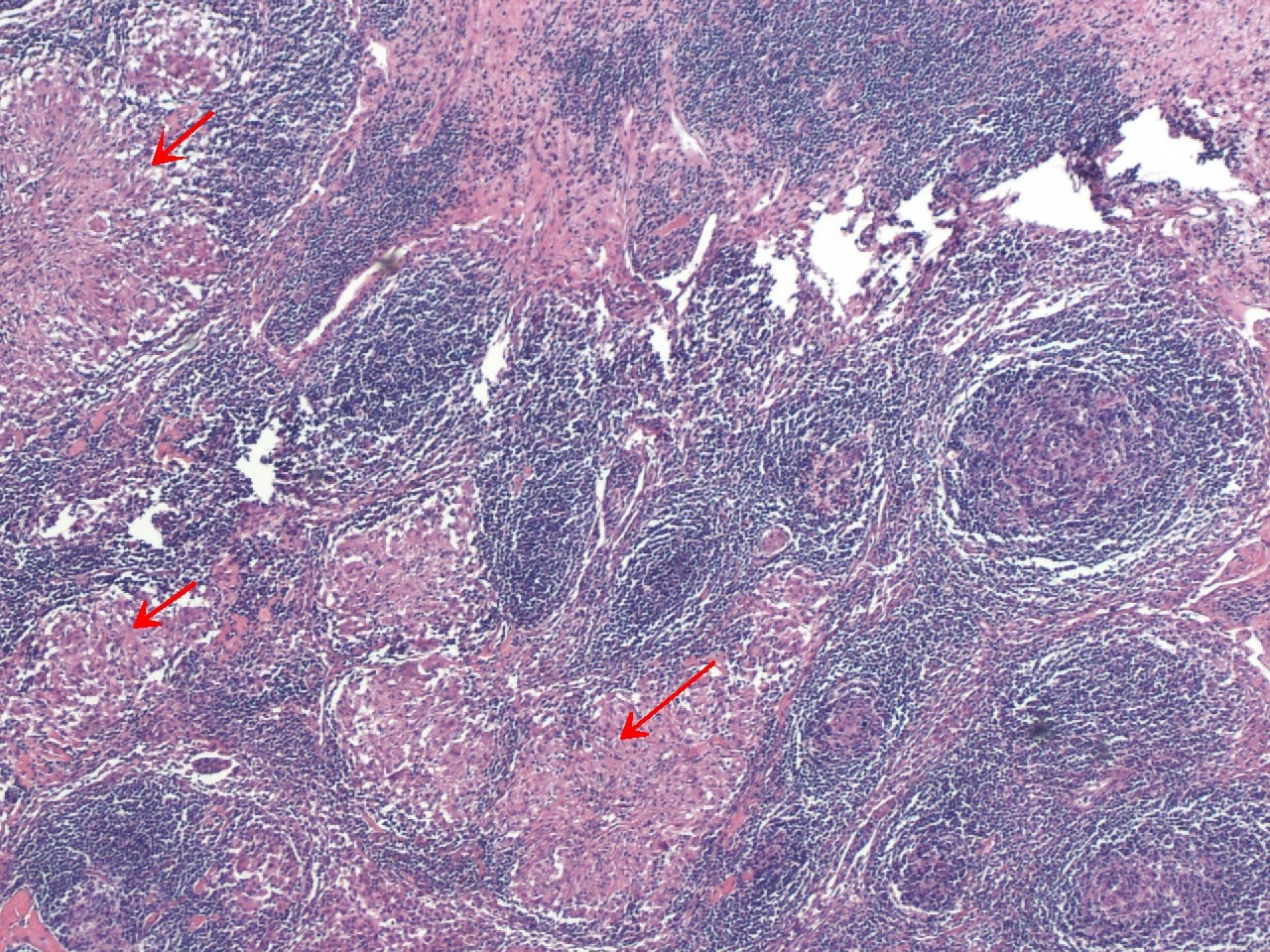Back


Poster Session C - Monday Afternoon
Category: Biliary/Pancreas
C0072 - Sarcoidosis Masquerading as Pancreatic Adenocarcinoma: A Case Report
Monday, October 24, 2022
3:00 PM – 5:00 PM ET
Location: Crown Ballroom

Has Audio

Andrew Mims, MD
The University of Tennessee Health Science Center
Chattanooga, TN
Presenting Author(s)
Award: Presidential Poster Award
Andrew Mims, MD1, Michael Cataldo, MD2, Sean Rice, MD1
1The University of Tennessee Health Science Center, Chattanooga, TN; 2University of Tennessee Health Science Center, Chattanooga, TN
Introduction: Sarcoidosis is a multisystem, idiopathic disease characterized by granulomatous inflammation. Symptomatic involvement of the GI tract occurs in less than 1% of cases, and of those, the stomach is most involved. Pancreatic involvement is exceedingly rare. The diagnosis of pancreatic sarcoidosis remains difficult, as pancreatic involvement may manifest as direct invasion of the organ, obstruction of the pancreatic or biliary ducts, or as a mimicker of pancreatic adenocarcinoma. We present a rare case of suspected pancreatic malignancy revealed as pancreatic sarcoid after surgical resection, in a patient without known history of sarcoidosis.
Case Description/Methods: A 50 year old M presented to the GI clinic reporting 3-4 years of epigastric pain with 30 pound weight loss. CT demonstrated a 2.6 cm mass-like lesion with infiltrative margins in the pancreatic head and uncinate process with mild biliary and pancreatic ductal dilation, highly suspicious for pancreatic adenocarcinoma. He twice underwent EUS which each revealed biliary dilatation with a mass in the head of the pancreas, with pathology showing chronic inflammation. Follow up PET scan, however, revealed a lesion in the pancreatic head that had mild FDG uptake suspicious for malignancy. Patient underwent Whipple without complication. Pathology was fortunately negative for malignancy, however revealed granulomatous inflammation in the pancreas. Findings suggestive of sarcoidosis. At follow up, patient had no evident additional manifestations of sarcoidosis.
Discussion: Pancreatic involvement in sarcoidosis can manifest in many ways, including mimicking pancreatic adenocarcinoma. Given that pancreatic cancer typically portends a poor prognosis, there is greater urgency in diagnosis and treatment for suspicious pancreatic masses. A high degree of clinical suspicion is necessary to consider sarcoidosis in this setting. Our case was particularly interesting because this patient had no personal or family history of sarcoidosis and experienced no other signs or symptoms of sarcoidosis after his Whipple procedure. This patient had 2 separate EUS procedures with no evidence of malignancy, however a PET scan was concerning for pancreatic malignancy. This provided a difficult clinical circumstance, as this patient suffered from debilitating abdominal pain with no definitive diagnosis and thus no definitive treatment option. Ultimately, patient underwent Whipple procedure with relief of symptoms, and a situationally fortunate diagnosis of sarcoidosis.

Disclosures:
Andrew Mims, MD1, Michael Cataldo, MD2, Sean Rice, MD1. C0072 - Sarcoidosis Masquerading as Pancreatic Adenocarcinoma: A Case Report, ACG 2022 Annual Scientific Meeting Abstracts. Charlotte, NC: American College of Gastroenterology.
Andrew Mims, MD1, Michael Cataldo, MD2, Sean Rice, MD1
1The University of Tennessee Health Science Center, Chattanooga, TN; 2University of Tennessee Health Science Center, Chattanooga, TN
Introduction: Sarcoidosis is a multisystem, idiopathic disease characterized by granulomatous inflammation. Symptomatic involvement of the GI tract occurs in less than 1% of cases, and of those, the stomach is most involved. Pancreatic involvement is exceedingly rare. The diagnosis of pancreatic sarcoidosis remains difficult, as pancreatic involvement may manifest as direct invasion of the organ, obstruction of the pancreatic or biliary ducts, or as a mimicker of pancreatic adenocarcinoma. We present a rare case of suspected pancreatic malignancy revealed as pancreatic sarcoid after surgical resection, in a patient without known history of sarcoidosis.
Case Description/Methods: A 50 year old M presented to the GI clinic reporting 3-4 years of epigastric pain with 30 pound weight loss. CT demonstrated a 2.6 cm mass-like lesion with infiltrative margins in the pancreatic head and uncinate process with mild biliary and pancreatic ductal dilation, highly suspicious for pancreatic adenocarcinoma. He twice underwent EUS which each revealed biliary dilatation with a mass in the head of the pancreas, with pathology showing chronic inflammation. Follow up PET scan, however, revealed a lesion in the pancreatic head that had mild FDG uptake suspicious for malignancy. Patient underwent Whipple without complication. Pathology was fortunately negative for malignancy, however revealed granulomatous inflammation in the pancreas. Findings suggestive of sarcoidosis. At follow up, patient had no evident additional manifestations of sarcoidosis.
Discussion: Pancreatic involvement in sarcoidosis can manifest in many ways, including mimicking pancreatic adenocarcinoma. Given that pancreatic cancer typically portends a poor prognosis, there is greater urgency in diagnosis and treatment for suspicious pancreatic masses. A high degree of clinical suspicion is necessary to consider sarcoidosis in this setting. Our case was particularly interesting because this patient had no personal or family history of sarcoidosis and experienced no other signs or symptoms of sarcoidosis after his Whipple procedure. This patient had 2 separate EUS procedures with no evidence of malignancy, however a PET scan was concerning for pancreatic malignancy. This provided a difficult clinical circumstance, as this patient suffered from debilitating abdominal pain with no definitive diagnosis and thus no definitive treatment option. Ultimately, patient underwent Whipple procedure with relief of symptoms, and a situationally fortunate diagnosis of sarcoidosis.

Figure: Pathology slide revealing Non necrotizing granulomas within a peripancreatic lymph node
Disclosures:
Andrew Mims indicated no relevant financial relationships.
Michael Cataldo indicated no relevant financial relationships.
Sean Rice indicated no relevant financial relationships.
Andrew Mims, MD1, Michael Cataldo, MD2, Sean Rice, MD1. C0072 - Sarcoidosis Masquerading as Pancreatic Adenocarcinoma: A Case Report, ACG 2022 Annual Scientific Meeting Abstracts. Charlotte, NC: American College of Gastroenterology.

